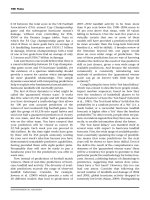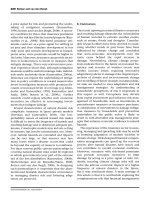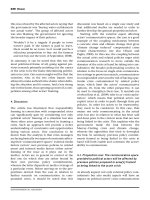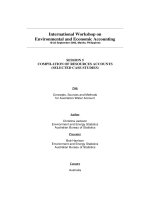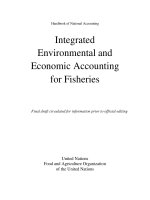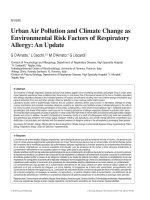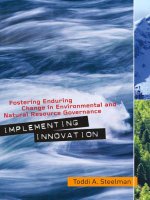Climate change as environmental and economic hazard - phần 1.2
Bạn đang xem bản rút gọn của tài liệu. Xem và tải ngay bản đầy đủ của tài liệu tại đây (78.87 KB, 8 trang )
they face (Adger et al., 2003; Sua
´
rez et al., 2005).
However, both contemporary and historical case
studies, especially those in Africa and Asia-Pacific,
have demonstrated that resilience is strong. Yet
populations and communities have a new chal-
lenge to face that will certainly test this resilience.
The rate of change driven by increased anthro-
pogenic GHG emissions continues to accelerate
faster than previously anticipated (IPCC 2007;
Rahmstorf et al., 2007; Smith et al., 2009). This
is illustrated by one of the manifestations of
climate change, the increasing intensity and fre-
quency of natural disasters and extreme weather
events (Srinivas and Nakagawa, 2008; Smith
et al., 2009). The rate of increase of disasters as
well as the numbers of people affected by these
hazard events has been dramatic over the past
decade (IFRC, 2003). Thus, the urgency to
respond to these changes, even in the face of
uncertainty, has become much more pressing
and presents the need for assisted adaptation.
These recent trends have placed disasters at the
centre of human–environment debates and have
linked them with issues of development, techno-
logy and economic resiliency (Schipper and
Pelling, 2006). As a response to this concern,
international governance bodies, national gov-
ernments, development agencies and organiz-
ations, non-governmental and non-profit
organizations and private enterprise are creating
mitigative and adaptive responses to these issues
(Smit and Wandel, 2006). Special attention has
been given to developing nations, which are con-
sidered to be the most vulnerable to the risks and
pressures exerted by environmental change. In
order to confront this, research endeavours, poli-
cies and practices that enhance resilience must be
considered as a way to respond to a world that is
in constant change (Pelling and Uitto, 2001).
In this article, we review the current under-
standing of natural and social disasters, the para-
digm shifts in disaster management, the
emergence of climate change adaptation (CCA)
and the linkages between CCA and disaster risk
reduction (DRR). Current scholarly and prac-
titioner attempts to link the two fields are
described, and we propose an urgent need for a
holistic and dynamic systems approach, focusing
on socio-ecological resilience as an opportunity
to increase collaboration between the fields. We
suggest two mechanisms to achieve this: (1) the
use of iterative risk management as a primary
instrument for adaptive decision making and (2)
the establishment of boundary organizations
and institutional changes to increase the transfer
of knowledge between science, policy and practice.
The thoughts presented throughout this
review are informed by a recent Forum held on
23–24 April 2009 at the Yale School of Forestry
and Environmental Studies, entitled ‘A Dynamic
Systems Approach to Socio-ecological Resilience
and Disaster Risk Reduction: Prioritizing the
Gaps in a Changing World’. The two-day event
covered many aspects of CCA, DRR and socio-
ecological resilience. The participants, who are
researchers, practitioners and policy makers,
were charged with crossing traditional disciplines
and boundaries to indentify and prioritize gaps
and ways forward to link the fields of CCA and
DRR for a holistic systems approach to deal with
the inherent uncertainty associated with climate
change and hazard events.
1.1. Understanding natural and social disasters
There is a significant body of literature regarding
conceptualizations and definitions of disasters
in the social science literature (e.g. Quarantelli
and Dynes, 1977; Turner and Pidgeon, 1978;
Quarantelli, 1988; 1998; Oliver-Smith, 1996).
One such example is Oliver-Smith (1996, p. 303)
who defines disasters as ‘a process or event invol-
ving a combination of a potentially destructive
agent(s) from the natural and/or technological
environment and a population in a socially and
technologically produced state of vulnerability’.
Thus, natural disasters are the result of the inter-
action between a vulnerable population and a
hazard event. Consequently, climate change
will have a twofold effect on disaster risk: (1)
through the increase in weather and climate
hazards, and (2) through an increase in social vul-
nerability to these hazards. By exacerbating
172 Collier et al.
ENVIRONMENTAL HAZARDS
ecosystem degradation and affecting livelihoods
at the local level, climate change will become an
additional stressor as well as an inhibitor for com-
munities’ coping capacity (ISDR, 2002).
High vulnerability and low adaptive capacity
have been associated with societies with a high
dependence on natural resources (World Bank,
2000). This echoes the concern of the Intergov-
ernmental Panel on Climate Change (IPCC) for
low-lying coastal and island regions whose popu-
lations are highly reliant on natural resources;
current adaptation for these communities is
unbalanced and ‘readiness for increased exposure
is low’ (IPCC, 2007, p. 15). Many of these regions
are the most disaster-prone in the world and have
experienced disaster relief and development
interventions for decades. Yet resilience is still
considered low in these countries. The lingering
question, therefore, is ‘why?’ We will return to
this question in detail later, but will first supply
a background of the emergence of several impor-
tant paradigm shifts.
1.2. From disaster response to disaster risk
reduction
Since the 1970s, the disaster relief and humanita-
rian community has gone through several impor-
tant paradigm shifts. The community, over the
years, has refined its understanding and manage-
ment of disasters, from identifying and respond-
ing to hazard events to determining and
targeting the underlying drivers of vulnerability
that turn hazards into disasters. Although the
shifts are more recent, Carr (1932) proposed the
conceptual model for many of these ideas much
earlier. An important shift in the practitioner
community came in the early 1980s, when the
US Federal Emergency Management Agency
(FEMA) proposed an approach to disaster man-
agement that distinguished between mitigation,
preparedness, response and recovery. Similarly,
following the International Decade for Natural
Disaster Reduction (IDNDR) (1990–1999), the
United Nations International Strategy for Disas-
ter Reduction (ISDR) was mandated to focus on
the paradigm shift from disaster mitigation to
disaster prevention, also known as DRR. At the
interim of the IDNDR, the Yokohama Strategy
and Plan of Action for a Safer World led to a
change in thinking about disaster mitigation
(Schipper and Pelling, 2006). Movement in think-
ing and practice continued during the United
Nations World Conference on Disaster Reduction
(WCDR) in 2005 (Schipper and Pelling, 2006). As
a result, the Hyogo Framework for Action (HFA)
(2005–2015) was established as an international
commitment providing technical and political
agreement on issues necessary to reduce disaster
risk. Ultimately, these shifts led to the newly
recognized DRR framework. ISDR promoted this
framework to development and humanitarian
organizations worldwide. The combined efforts
of various stakeholders produced an increasing
desire to identify actions that promote reducing
vulnerability before hazards can result in undesir-
able impacts, particularly within the context of
climate change (Klein et al., 2003). This interest
continues to date. In fact, the forthcoming IPCC
Assessment Report (AR5) will have a distinct
chapter on DRR as an adaptation strategy, and
the IPCC is also developing a Special Report on
managing the risks of extreme events and
hazards, focusing largely on DRR (IISD, 2009).
Despite the efforts of the past several decades,
including preventative measures that have been
demonstrated to be more economically efficient
than reactive ones, disaster relief, response and
recovery still predominate. This is also discoura-
ging because a growing body of literature suggests
that post-disaster response can actually increase
vulnerabilities in the long term (Anderson and
Woodrow, 1998; Schipper and Pelling, 2006).
Nonetheless, as the emphasis continues to shift
from disaster response to DRR, greater and sus-
tained efforts are needed to make these changes
within research institutions as well as develop-
ment and humanitarian agencies and organiz-
ations (Linnerooth-Bayer et al., 2005). In such
efforts, many institutions, agencies and organiz-
ations are developing analytical tools for disaster
management, to identify indicators for effective
disaster preparedness in the hopes of helping
Strengthening socio-ecological resilience 173
ENVIRONMENTAL HAZARDS
communities to reduce their risk from disasters.
Likewise, Schipper and Pelling (2006) suggest
that such risk appraisal and assessment method-
ologies could prove significant in designing
development strategies in the future.
1.3. The emergence of climate change
adaptation
CCA emerged from the international treaty of the
UN Framework Convention on Climate Change
(UNFCCC) in 1992, especially for developing
country parties through Article 4. CCA has been
given second priority to climate change mitigation
(CCM) since its inception, however, because of a
perceived sense of greater urgency to slow the
pace of emissions in response to Article 2 obli-
gations about avoiding dangerous anthropogenic
interference to the climate system (Pielke, 1998;
Schipper and Pelling, 2006). For example, the
Kyoto Protocol (2008–2012), an international
agreement linked to the UNFCCC, sets legally
binding targets for the reduction of GHG emis-
sions but has only little emphasis on CCA. Many
parties have disagreed on this prioritization,
notably developing countries.
Limited success to date in CCM and increased
clarity in climate change signals have made
parties realize the importance and parallel
urgency of adaptive measures and policies.
Indeed, IPCC (2007) concludes that observed
impacts from climate change to which the
planet is already committed would continue
throughout the next century even if GHG emis-
sions were cut to zero. So, while CCM has tra-
ditionally been the pivotal issue for many
climate change experts, CCA is now widely
acknowledged as necessary for responding effec-
tively and equitably to the impacts of climate
change. In recent years, CCA has become a key
focus of the scientific and policy-making com-
munities and is now a major area of discussion
under the UNFCCC. The Seventh Conference
of the Parties (COP7) in 2001 addressed the
special concerns of the world’s 38 Least Devel-
oped Countries (LDCs), which were given an
opportunity to develop National Adaptation
Programmes of Action (NAPAs). Similarly, at
the Eleventh Conference of the Parties (COP11)
in 2005 the Nairobi Work Programme (NWP)
(2005–2010) was established to focus exclu-
sively on impacts, vulnerabilities and adap-
tation. CCA gained further recognition at the
Thirteenth Conference of the Parties (COP13)
in 2007 when the Bali Road Map (BRM) and
Bali Action Plan (BAP), which chart a path to
move forward post-Kyoto Protocol, gave equal
priority to both CCM and CCA. The BAP also
identified risk management and DRR as impor-
tant elements for CCA moving forward.
Governments, institutions, researchers, prac-
titioners and populations are all preparing for
the CCA challenge posed to societies. In such
efforts, Klein and Tol (1997) and Huq and Klein
(2003) have developed approaches to anticipat-
ory adaptation. Increased importance of CCA
and identification of DRR has led to numerous
initiatives that address both DRR and CCA (e.g.
UNISDR Working Group on Climate Change
and the Red Cross/Red Crescent Climate
Change Center), suggesting that DRR has much
to contribute to CCA policy and research
(Handmer, 2003).
Community-based adaptation (CBA) is one
innovative approach to CCA that focuses on
enabling communities to enhance their own
adaptive capacity, thereby empowering vulner-
able communities to increase their own resilience
to the impacts of climate change. CBA identifies,
assists and implements community-based activi-
ties, research and policy in regions where adap-
tive capacity is as dependent on livelihoods as
climatic changes. While CBA has strong merits
for strengthening the resilience of communities,
it cannot, however, be viewed as a panacea. We
propose, as have others (e.g. O’Brien et al., 2006;
Schipper and Pelling 2006; Thomalla et al.,
2006), that CCA and DRR must to be integrated
together into a larger, holistic and systems-based
approach, and that CBA techniques could play
an important role in achieving many of the
desired goals towards increasing socio-ecological
resilience and reducing disaster risk.
174 Collier et al.
ENVIRONMENTAL HAZARDS
2. Linking disaster risk reduction and climate
change adaptation
It has become apparent that climate change will
not only be expressed through slow-onset
changes in trends and average conditions over a
long period, but also through non-linear and
stochastic shifts in the frequency, intensity and
severity of extreme events. The disaster relief com-
munity has great experience with droughts, floods,
heat waves and cyclones, but only recently have
disaster scholars and practitioners engaged in
climate change debates (Helmer and Hilhorst,
2006). One of the most evident distinctions
between DRR and CCA is that, while CCA focuses
solely on the disturbances attributed to the
dynamic climate system, DRR deals with all types
of hazards, which include geophysical hazards
as well (Schipper and Pelling, 2006). Both stress
recent emphasis of working with communities,
either by addressing risk aspects of climate change
(in the case of DRR) or increasing resilience
through CBA (in the case of CCA) (Næss et al.,
2005; Tompkins, 2005; Penning-Rowsell, 2006).
In attempts to link the two fields, it is noted that
the ‘core insight disaster studies can bring to
climate-related research is that vulnerability is criti-
cal to discerning the nature of disasters’ (Helmer
and Hilhorst, 2006, p. 2). Thus, as the intensity
and frequency of disasters increases, it becomes a
requirement for DRR and CCA also to increase resi-
lience (Helmer and Hilhorst, 2006, p. 3).
The IPCC Fourth Assessment Report (AR4)
(2007) identifies the usefulness of taking a risk
perspective in order to identify synergies to
‘promote sustainable development, reduce the
risk of climate-related damage, and take advan-
tage of climate-related opportunities’. For years,
the UNISDR was internally attempting to link
CCA and DRR and until recently was largely
unsuccessful. On 29 September 2008, the UN
Secretary General Ban Ki-Moon made the follow-
ing statement at a ministerial meeting he
specially convened in New York:
If we are too slow to adapt to climate change,
we risk making disasters even more catastrophic
than they need to be. We must draw on the
Hyogo Framework for Action and disaster risk
reduction knowledge to protect the world’s
most vulnerable populations against climate
change (Ban Ki-Moon, 2008).
This meeting officially linked the UN programme
areas of CCA and DRR at the international level.
Furthermore, at this meeting the Secretary
General called on ministers to lead the way at
the UNFCCC negotiations by championing
DRR as a core element of CCA. This was a critical
step for developing countries and has opened
the door for collaboration between the two
disciplines to share much-needed resources,
ultimately leading towards more effective pro-
tection of the most vulnerable populations.
While DRR is relatively new and constantly
developing new methods, CCA is even younger.
At this early stage of development, the inte-
gration of these two fields holds significant
potential to address the impacts of climate
change and reduce vulnerable populations’ risk
from disaster.
Most importantly though, while there have
been some notable exceptions, few research
initiatives are actually aimed at answering prac-
titioner questions (Helmer and Hilhorst, 2006).
We defer to Kellenberg and Mobarak (2008) to
illustrate an exception that addresses an impor-
tant practitioner concern. The authors show
that previous literature and understanding on
the negative relationship between income per
capita and measures of risk from natural disasters
missed an important point: behavioural changes
at the microlevel in response to increasing
income may lead to a nonlinear relationship
between aggregating incomes and disaster
damages, where risks increase with income
before they decrease. This suggests that the dual
goals of DRR and economic development
cannot be assumed to be complementary for all
forms of natural disasters, specifically flooding,
landslides and windstorms. Extreme temperature
events and earthquakes seem to follow the tra-
ditional thought more closely. This has signifi-
cant policy and practical implications for
Strengthening socio-ecological resilience 175
ENVIRONMENTAL HAZARDS
developing, and particularly least developed,
countries. To again elucidate the link to CCA,
those divergent disasters (i.e. flooding, landslides
and windstorms) are all hazards that projections
show will increase with climate change (IPCC,
2007).
3. Resilience as a dynamic systems concept
A detailed body of literature over previous
decades has shown that many of the world’s eco-
logical problems originate from social problems,
especially under dominant and hierarchal socio-
political regimes. Consequently, in order to
understand and deal with ecological problems,
societal problems must be addressed. In consider-
ing socio-ecological systems, socio-economic resi-
lience may be considered to have a higher impact
than biophysical resilience (Young et al., 2006).
Traditionally, research on adaptation to
environmental change has been centred on the
responses of different social entities to environ-
mental stimuli. Alternatively, the resilience
approach is based on a holistic perspective that
anticipates dynamic change and views adaptive
capacity as an essential characteristic of socio-
ecological systems. The resilience approach also
provides a framework through which CCA pro-
cesses can be analysed and policies can be ident-
ified. The approach allows for greater flexibility in
CCA, since it envisions the possibility of change
in the state of systems itself. Thus, the approach
fosters the prevalence of those characteristics that
allow the system to assimilate perturbations
without losing their autonomy (i.e. function, net-
works, social capital, etc.) in a dynamic environ-
ment (Nelson et al., 2007). Folke states:
The implication for policy is profound and
requires a shift in mental models toward
human-in-the-environment perspectives, acc-
eptance of the limitation of policies based on
steady-state thinking and design of incentives
that stimulate the emergence of adaptive gov-
ernance for social-ecological resilience of land-
scapes and seascapes (Folke, 2006, p. 263).
The term resilience has been used metaphorically
in a socio-ecological context since the 1970s.
Almost four decades later, there seems to have
been little clarity attained in regard to what
makes a system resilient or how resilience can
be enhanced (Klein et al., 2003). Some theorists
use this term to refer to the ability of certain
societies to adapt and cope with external
shocks. In fact, in development practice it is
widely assumed that a more resilient system is
less vulnerable to hazards (Klein et al., 2003).
Holling (1973) first introduced the concept of a
resilient ecosystem by defining it as a measure of
the ability of ecosystems to absorb change and
persist beyond that change. This work is highly
valuable in that it contrasts the concept of resili-
ence with that of stability. A stable ecosystem is
one considered to return to a state of equilibrium
after a temporary disturbance (Holling, 1973).
Accordingly, a stable ecosystem would return to
equilibrium quickly without major fluctuations,
whereas a resilient system may reach high
points of instability and fluctuation in a path
towards dynamic change. This conceptualization
is essential for applicability purposes, given the
fact that systems, as we define them today, are
dynamic and in constant change as they
respond to both external and internal influences
(Klein et al., 2003).
Carpenter et al. (2001) define resilience as the
magnitude of disturbance that can be tolerated
before a socio-ecological system moves into a
different region of state-space controlled by a
different set of processes. Accordingly, resilience
may be considered in multiple contexts: in
relation to sustainability, as a property of
dynamic models and as a quantifiable variable
that can be assessed through location-specific
field studies. In order to accomplish this last
point, there must be a general understanding of
the socio-ecological system and disturbances
must be identified (Carpenter et al., 2001).
As these ideas developed from an ecosystem
perspective, resilience became a concept of
value for economic and social studies as well.
Certain ecological economists who considered
resilience to be key to sustainability addressed
176 Collier et al.
ENVIRONMENTAL HAZARDS


